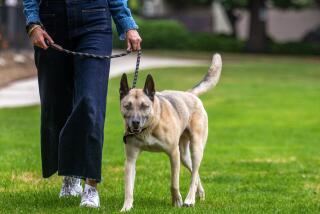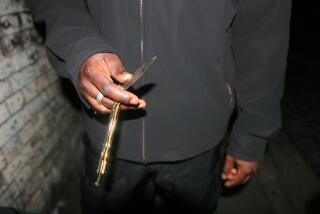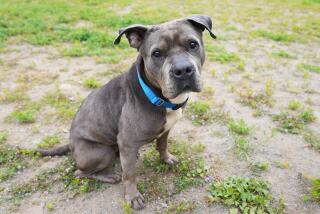Pit Bull Law Barking Up the Wrong Tree
- Share via
Are pit bulls such vicious dogs that they represent a clear and present danger to people and other animals? Or are they the only all-American dog by virtue of their courage and loyalty?
All over the country, news reports of attacks by dogs identified as pit bulls fuel a growing furor over the animals. Here, as elsewhere, much of the public debate is conducted in extreme terms and without benefit of unemotional, unbiased information about the unique history of pit bulls and the nature of the dogs today.
Many people, appalled by media accounts of brutal maulings, demand that all pit bulls be banished or, at the very least, muzzled in public. Authorities in San Diego and other communities across the country respond by passing or considering passage of local ordinances aimed specifically at the definition of a pit bull.
Pit bull owners, breeders and defenders then react to talk of breed-specific ordinances with an automatic recitation of their dogs’ ideal qualities and accuse the media of fanning the fires of public hysteria by sensationalizing pit bull attacks while ignoring, or at least downplaying, attacks by other breeds.
But the defenders cannot deny available data that indicates that dogs identified as pit bulls are overrepresented in fatal attacks on people.
According to statistics gathered by the Humane Society of the United States, 15 people have died of injuries suffered in attacks by dogs in the last 18 months. In 10 of those cases, the attacking dogs were pit bulls.
As startling as those statistics are, the Humane Society cautions that the lack of accurate and complete national records makes it impossible to prove that pit bulls are any more of a threat to public safety than any other kind of dog.
In the first place, there is widespread ignorance and disagreement about what a pit bull is or looks like. The breeds most often identified as pit bulls are the American pit bull terrier, the American Staffordshire terrier, the Staffordshire bull terrier and the bull terrier. The latter two are relatively rare in this country and have not been implicated in any serious or fatal attacks. But there is no doubt of the violent history of all four breeds.
Their ancestors were bred for centuries for one purpose: To fight other animals. Over the years, the fighting dogs were genetically selected for some remarkably un-canine, combative characteristics. Unlike most dogs, pit bulls often attack without warning, are willing to fight on regardless of the consequences, and are relatively insensitive to pain.
That legacy helps explain pit bull attacks on other animals, but it does not explain attacks on people because the fighting dogs also were carefully selected to be docile with people.
Recently, however, a new kind of dogfighter, pit bull owner and breeder has emerged--with a new kind of dog. The original fighting dogs would never bite a person, but lately some have even jumped pit walls at dogfights and gone after spectators.
The new breed of owner and fighter wants the “baddest” dog on the block and will abuse it and otherwise encourage viciousness. They steal other dogs and match them against their pit bulls or sic their dogs on their neighbors’ small pets. None of the other animals stands a chance against a pit bull.
Ten or 20 years ago, pit bulls were a rarity, but now their numbers are increasing dramatically, and they are showing up in animal shelters and in classified advertisements. The demand for the dogs increases, Humane Society investigators say, whenever there is a well-publicized attack by a pit bull.
As the dogs become more popular, backyard breeders start mass producing and inbreeding puppies for profit--with little regard for temperament or the very real possibility of perpetuating a genetic “loose screw.”
The remaining responsible breeders carefully select their dogs for temperament, and they socialize the puppies from birth. One breeder of American pit bull terriers, who grew up around pit bulls and old-line dogfighters, exposes her puppies to everything from crying babies to shopping centers. In despair over the kind of people looking for the dogs now, she says she may choose to destroy her current litter of puppies rather than take the risk that they will fall into the wrong hands.
The dogs, she said, are victims just as surely as the people mauled by pit bulls. Banning them would only victimize them further. Instead, the solution to attacks by pit bulls and other dogs lies in vigorous enforcement of strict, generic, vicious-dog ordinances. Such a law was passed in Rhode Island in 1985, and newspaper reports indicate that the number of dog bites there has dropped significantly.
Strict enforcement of anti-dogfighting laws, not a high priority so far, may also have a domino effect on the problem of vicious dogs because a large number of the dogs involved in recent fatal attacks were fighting dogs or belonged to dogfighters.
Although dogfighting is illegal in all 50 states, the brutal “sport” continues to flourish underground throughout the country, including San Diego.
Most important of all, the blame for vicious dogs must be placed where it belongs--on people.
After all, the dogs are products of their environment, and it is because of their treatment and selective breeding by humans that they become conditioned for hunting, guiding, guarding, fighting, being companions and, yes, even made vicious.
More to Read
Sign up for Essential California
The most important California stories and recommendations in your inbox every morning.
You may occasionally receive promotional content from the Los Angeles Times.













